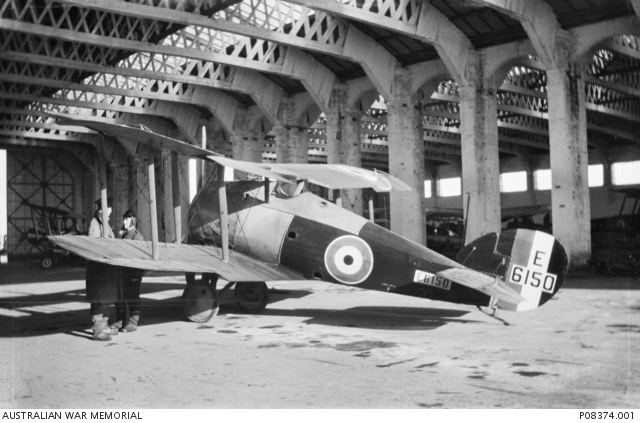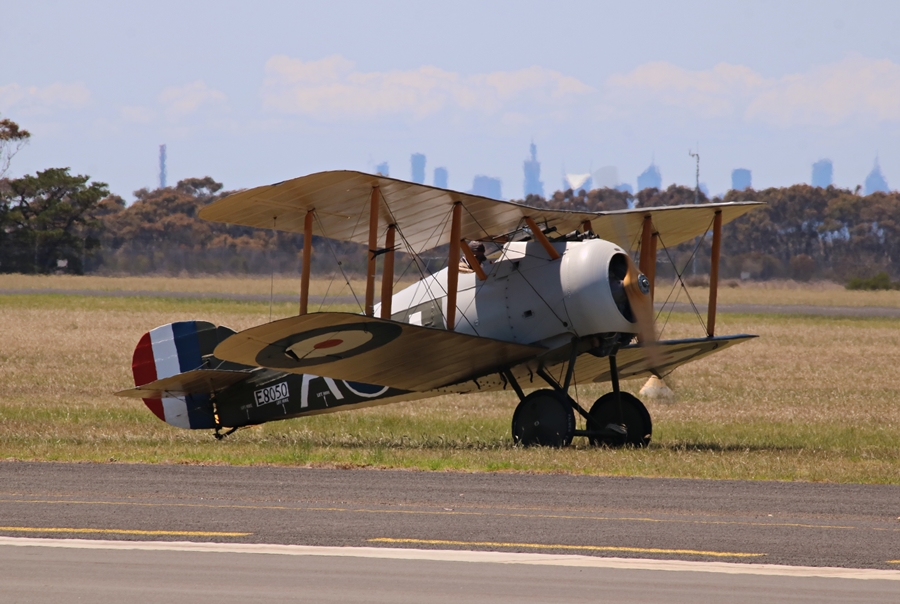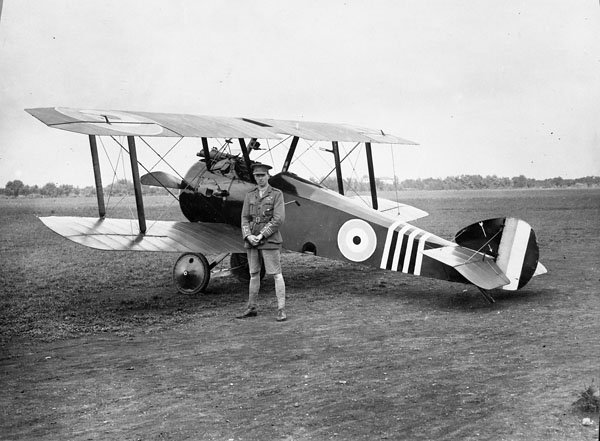During World War One the replacement for the Sopwith Camel scout fighter was the Sopwith Snipe biplane. Designed by Herbert Smith of the Sopwith Aviation Company, the Snipe first flew in October 1917 but with developmental issues that took a year to iron out (including initial pilot complaints of an inadequate rudder that was too small and heavy ailerons), it only entered operational service in limited numbers on the Western Front in August 1918 (less than 100).

The Snipe was seen as the ultimate development of small rotary engine fighter aircraft and although not as maneuverable as the Sopwith Camel, it was much easier to fly, faster, had a good rate of climb, performed well at higher altitude and importantly gave the pilot a much better field of view! Despite these improvements over what could be an extremely unforgiving and dangerous aircraft to fly, apparently many experienced Royal Flying Corps pilots were reluctant to give up flying their Sopwith Camel fighters but grew to like the Snipe. In the end the Snipe just lacked that ability to conduct a violent, lightning fast maneuver like the Camel.
The Snipe was powered by a 230 hp Bentley B.R.2 9 cylinder rotary engine, had a top speed of 195 km/h (121 mph), a service ceiling of 5,945 metres (19,500 feet) and had a flight endurance of 3 hours. Armament consisted of 2 x nose mounted synchronized 0.303 Vickers machine guns (7.7mm) and for ground attack it could carry 4 x 11kg (25lb) bombs underwing.

On the Western Front from October 1918, the Sopwith Snipe was operated by the Australian Flying Corps and Royal Flying Corps/Royal Air Force but only AFC No. 4 Squadron (AFC No. 5 & 8 Training Squadrons also operated the type in England) and RAF No. 43 Squadron saw action flying the Snipe. The AFC soon started to claim a number of victories with the type with 19 victories alone between October 26th and 29th, 1918.

German pilot Ernst Bormann flying with the elite Jasta 2 or Jasta “Boelcke“ as it was known (after the famous German air ace), tangled with AFC No. 4 Squadron Sopwith Snipe fighters on November 4th, 1918. The Aussies outnumbered, shot down 3 Fokkers but also lost 3 Snipes in a wild melee of a dog fight, including one to Bormann (his 16th victory of an eventual 17. He would later become a Major General in the Luftwaffe during World War Two). The pilots lost on both sides were experienced pilots and the Aussies were flying the best British scout available. Bormann was quoted as saying it was the toughest dogfight Jasta “Boelcke” had encountered due to the Sopwith Snipe: “a new English fighter aeroplane much better in climb and maneuverability than the Fokker D.VII” (Van Wyngarden, Jagstaffel 2 Jasta “Boelcke”, Pg. 116-118).
The Sopwith Snipe flew in support the British Occupation Army in Germany until 1919 and also saw service during the Commonwealth intervention in the Russian Civil War between 1919 and 1920. One example was captured and pressed into service by the Bolsheviks.
Post war the RAF primarily used the Snipe in the night fighter role. Given it would have been well and truly obsolete prior to this date, the Snipe had a surprisingly long career and the last were not retired until 1926 (primarily due to budget restraints, new combat aircraft development was limited after the war). Two seat trainer variants continued on with the RAF until 1927 (at least 40 of this variant were built). Post war the Snipe was also flown by the Brazilian Navy (12 aircraft) and the Canadian Air Force (received after the war, No. 1 Squadron operated the type until 1923).

Of 497 Snipe aircraft produced (the British Air Ministry originally placed an order for 1,700 but the end of the war cut that drastically!), only two surviving original and complete examples exist today. One is at the Canada Aviation & Space Museum in Ottawa, Ontario and the other is on display at the Smithsonian National Air & Space Museum in Washington DC. As with its predecessor, there are a number of static and flying Snipe replica/reproduction aircraft in museum and private collections too.

Canadian Air & Space Museum
I visited this excellent museum in 2013 and was impressed with their aviation collection. The Sopwith 7F.1 Snipe scout fighter (E6938) on display was built by the Nieuport & General Aircraft Company Ltd. of England in 1918, saw no combat in Europe but was on charge with RAF No. 37 Squadron in 1919.



This particular Snipe was imported to California in 1926 by English actor and aviator Reginald Denny, who had also served in the Royal Flying Corps during World War One. It was used in some movies including “Hells Angels” by Howard Hughes, before being restored by Jack Canary between 1953 to 1960. It joined the museum collection in 1964. It was still flying until damaged in 1967.
Canadian War Museum
The Canadian War Museum also in Ottawa, has a significant piece history in the form of the fuselage of the Sopwith 7F.1 Snipe (E8102) flown by Canadian Ace Major William G. “Billy” Barker but it is without landing gear, wings, engine and cowl. Barker flew with the RFC/RAF on the Western and Italian Fronts, first as an observer/gunner (1915-1916) and later as a pilot (1917-1918), which included flying Sopwith Camel and Snipe scouts against German and Austro-Hungarian pilots.

“Billy” Barker finished the war with 50 air to air victories and was awarded a Victoria Cross (the highest award in the British Commonwealth) for actions whilst flying this Sopwith Snipe with RAF No. 201 Squadron on October 27th, 1918 when he was involved in five separate dog fights (with 15 Fokker D.VII’s in one engagement) and despite receiving multiple wounds and eventually crashing this aircraft, shot down 4 German aircraft in the process (the aircraft was recovered and designated an official war trophy)! His other awards included the Distinguished Service Order (DSO and bar) and the Military Cross (with 2 Bars) for his brave actions, making him the most decorated Canadian serviceman.

Smithsonian National Air & Space Museum
Sopwith 7F.1 Snipe (E8105) was built by the Ruston Proctor Company of Lincoln, England in 1918.
A gentleman by the name of Arthur Le Barron was possibly the person who imported the aircraft into the United States. In 1928 he then sold it to Leo Langevin in Binghamton, New York for restoration, including new fabric, refinishing the wooden frame and fitting a Clerget 9B rotary engine as used in the Sopwith Camel.
Sold in 1930 to Myron Romberger, it was converted to a two-seat aircraft before being sold again in 1932 to the Roosevelt Field aviation museum in Mineola, New York. It was purchased in 1951 by Cole Palen for the famous Old Rhinebeck Aerodrome Museum in Rhinebeck, New York, where he flew it until damaged in 1966. Following this accident it became a static museum display but also had an original Bentley B.R.2 rotary engine installed.
In 1987 the Snipe was loaned to NASM, who made some cosmetic restoration and put it on museum display in 1991. The aircraft was donated to NASM after Cole died in 1994. Unfortunately for some reason, despite going to the National Air & Space Museum multiple times since then, I seem to have taken only one poor quality photo of this particular Sopwith Snipe (my lack of photos probably has a lot to do with the placement of the aircraft, suspended in a small space)! As such I have added some antique effects to make it a little more presentable…

References
Ace Pilots – William G. “Billy” Barker
Canadian Air & Space Museum – Sopwith Snipe
Fire in the Sky: The Australian Flying Corps in the First World War by Michael Molkentin (2010)
RAF Museum – Sopwith Snipe & Dragon

Great post – and the Snipe is such an amazing aircraft, to me really underscores just how fast aviation advanced in the First World War. Actually it always intrigues me how there was a whole new generation of aircraft just entering service around the time WW1 ended – Snipe, Cuckoo, those German parasol-wing monoplanes etc. It was good that the war ended when it did, of course, but part of me wonders how things might have panned out in the air had the Germans carried on into 1919.
LikeLiked by 1 person
Yes the jump in capability was vast in a short period of time. German supplies in the end were an issue and pilot flying time was limited but they kept producing great aircraft designs
LikeLiked by 1 person
Thanks a lot for your presentation of an aircraft, I must confess, I knew very little about. Great photographs, too!
LikeLiked by 1 person
Thanks. It was overshadowed by its predecessor
LikeLike